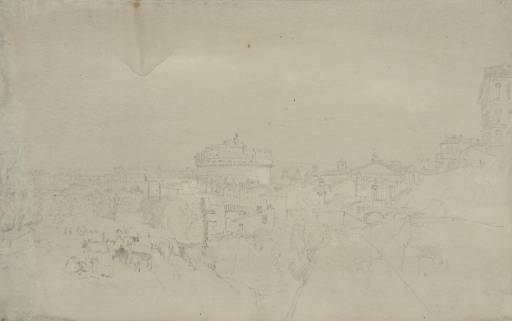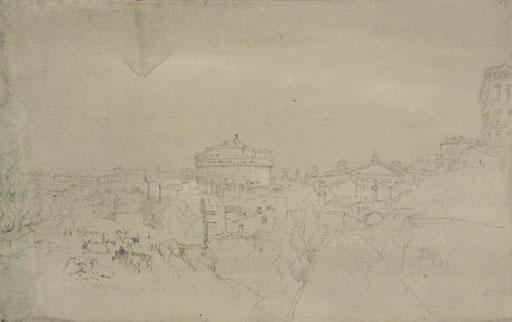Joseph Mallord William Turner View of Castel Sant'Angelo, Rome, from the Vatican 1819
Image 1 of 2
Joseph Mallord William Turner,
View of Castel Sant'Angelo, Rome, from the Vatican
1819
Joseph Mallord William Turner 1775–1851
View of Castel Sant’Angelo, Rome, from the Vatican 1819
D16336
Turner Bequest CLXXXIX 10
Turner Bequest CLXXXIX 10
Pencil and grey watercolour wash on white wove paper, 231 x 369 mm
Stamped in black ‘CLXXXIX 10’ bottom right
Stamped in black ‘CLXXXIX 10’ bottom right
Accepted by the nation as part of the Turner Bequest 1856
Exhibition history
1904
National Gallery, London, various dates to at least 1904 (262).
References
1904
E.T. Cook and Alexander Wedderburn (eds.), Library Edition: The Works of John Ruskin: Volume XIII: Turner: The Harbours of England; Catalogues and Notes, London 1904, no.262, pp.378, 622, as ‘Rome: The Castle of St. Angelo’.
1905
W[illiam] L[ionel] Wyllie, J.M.W. Turner, London 1905, reproduced opposite p.112.
1909
A.J. Finberg, A Complete Inventory of the Drawings of the Turner Bequest, London 1909, vol.I, p.562, as ‘Castle of St. Angelo. 262, N.G.’.
1914
Thomas Ashby, ‘Turner in Rome – II’, Burlington Magazine, vol.25, no.134, May 1914, p.104, reproduced Pl.II, C, as ‘View from the Bastion which Protected the Belvedere, towards the Porta Angelica’.
1920
D[ugald] S[utherland] MacColl, National Gallery, Millbank: Catalogue: Turner Collection, London 1920, p.87.
This sketch depicts a view of the Castel Sant’Angelo, a famous circular fortress which stands on the banks of the Tiber near St Peter’s and the Vatican in Rome. The vast size, striking shape and prominent location of the castle have made it one of the city’s most prominent landmarks. Originally the mausoleum of the Emperor Hadrian, the cylindrical building dates from AD 139 but was later converted from a tomb to a fortress, acting as part of the military defences of the city until the end of the nineteenth century. The name derives from a legendary vision of the Archangel Michael who reportedly appeared above the building sheathing his sword as a symbol of the end of a great plague in AD 590. Since 1753, a massive bronze statue of the angel by the Flemish sculptor Peter Anton Verschaeffelt (1710–1793) has crowned the top, replacing an earlier one in marble by Raffaelo da Montelupo (circa 1504–circa 1566).
Turner’s sketch depicts the Castel Sant’Angelo from the north-west looking towards the Porta Angelica in the centre. Thomas Ashby identified the artist’s viewpoint as the bastion constructed by Michelangelo which protected the Belvedere of the Vatican.1 On the far right-hand side of the composition is part of the Papal Palace, whilst to the right of the Castel Sant’Angelo can be seen Santa Maria delle Grazie, a seventeenth-century church which was demolished during the early twentieth century to make way for the Piazza del Risorgimento and the new walls of the Vatican City State.2 The open fields with grazing cattle on the left are the Prati di Castello (Meadows of the Castle). Today this area is entirely built up and the vista transformed. A similar view showing the road leading to the Porta Angelica can be seen in a painting by Giovanni Paolo Panini (1691–1765), Veduta di Roma da Nord-Ouest (Staatliche Museen Preussischer Kulturbesitz, Gemäldegalerie, Berlin).3 Like many studies within this sketchbook, the composition has been executed in pencil over a grey washed ground, although in this instance the paper has suffered from fading and discolouration
Other drawings featuring prominent views of the Castel Sant’Angelo can be found within this same sketchbook (see Tate D16329 and D16358; Turner Bequest CLXXXIX 3 and 32). The fortress also appears within a number of other sketches from the 1819 tour, see for example the St Peter’s sketchbook (D16214–6; Turner Bequest CLXXXVIII 33–34), the Tivoli and Rome sketchbook (Tate D14967 and D14973; Turner Bequest CLXXIX 22 and 26a), and the Small Roman C. Studies sketchbook (Tate D16405; Turner Bequest CXC 9). Furthermore, it later became the subject of two vignette watercolour illustrations for literary projects: Rome, Castle of St Angelo for Rogers’s Italy circa 1826–7 (see Tate D27677; Turner Bequest CCLXXX 160); and The Castle of St. Angelo for Byron’s Life and Works circa 1832 (Tate, N05243).
See an engraved view by Giuseppe Vasi, Chiesa di S. Maria delle Grazie 1756, reproduced at http://www.romeartlover.it/Vasi122b.htm , accessed October 2009.
Verso:
?Blank (pasted to mount).
Nicola Moorby
October 2009
How to cite
Nicola Moorby, ‘View of Castel Sant’Angelo, Rome, from the Vatican 1819 by Joseph Mallord William Turner’, catalogue entry, October 2009, in David Blayney Brown (ed.), J.M.W. Turner: Sketchbooks, Drawings and Watercolours, Tate Research Publication, December 2012, https://www


